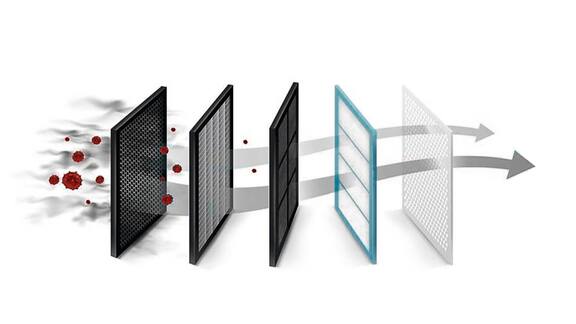Miele AirControl: Reducing the viral load in enclosed spaces with air purifiers
Rules governing social distancing, hand washing and mask wearing define what individuals can do to prevent the spread of SARS-Cov-2. Increasingly, this triad of protective measures is being joined by another important aspect, namely ventilation. But what if simply opening windows and doors alone is not enough or requires the support of further technical measures? This is precisely where air purifiers come in!

Corona: Risk of air-borne infection
Still very little is known about the viral load required to trigger a Covid-19 infection. It is, however, to be presumed that the risk of infection increases with the viral load. Alongside droplets with a particle size of around >5 μm (micrometre) which above all are responsible for transmission over short distances, aerosols have also been identified as carriers of viruses over recent months. Given their size and weight, droplets fall to the floor and their relevance in transmitting infections can be further reduced by wearing a non-medical mask or face covering. Aerosols with a particle size of <5 μm, on the other hand, remain suspended in air and travel with ease. If a person infected with SARS-CoV-2 is present in the room, particles containing viruses can soon accumulate in the air. This poses a great risk of infection – in particular in enclosed spaces with limited replacement of air.(1)
Replacement of air beneficial to health
Ventilation is a key pillar of any hygiene concept and, alongside social distancing, hygiene and the wearing of non-medical masks, is increasingly being recommended as an additional preventative measure. Opening windows is indubitably the best and most obvious way of providing a supply of fresh air: The replacement of room air with fresh air from outdoors reduces the number of particles carrying viruses through dilution. Yet opening windows wide to air rooms during the winter season poses problems: What effect does the energy loss through rooms cooling down have? How does ventilation impact the wellbeing of those inside? And what if the design of the premises is not conducive to cross-ventilation to displace air fast? Air purifiers which continuously scrub the air and rid it of particles through constant filtration can meaningfully complement the existing approach based on keeping a safe distance, washing hands, wearing masks and ventilating rooms. This permanently reduces the viral load, not just momentarily as is the case with ventilation.(2)

Air purifiers: three main functions
Air purifiers have an important contribution to make. These electrical units reduce the concentration of particles in room air on an ongoing basis and prevent any accumulation of air-borne contaminants such as SARS-CoV-2. Three primary criteria are key to the proper functioning of air purifiers:
- Filtration capacity
- Air volume flow rate
- Air distribution
Filtration capacity
Air purifiers filter room air and, in doing so, retain particles which carry viruses. The filtered air should on no account be enriched with noxious chemicals. Against this backdrop, Miele Professional has opted for a purely physical filtration process involving multiple filter layers to guarantee high-level efficiency.
1. Coarse air inlet filter
The coarse filter serves to hold back and filter out coarse particles >10 μm – such as pollen, lint and small paper clippings – as air enters the unit. This protects the filter cartridge inside the unit and extends replacement intervals, thereby reducing the need for maintenance.
2. Fine filter
The fine filter retains particles which are 1 to 10 μm in size. These include smoke, germs and bacteria. Together with the HEPA H14 filter(3), this filter forms a single unit housed in a cartridge and is fitted in an air-tight manner to prevent bleed air bypassing the unit. In other words, the entire air stream passes through the filter cartridge without any bleed air. A so-called filter leakage test can be performed according to the DIN EN ISO 14644-3 standard.
3. HEPA H14 high-performance particulate filter
The HEPA H14 filter is tested and certified according to the EN 1822-1 standard. It holds back 99.995% of particles with dimensions of 0.1 - 0.3 μm, including viruses and bacteria. Certified HEPA H14 filters are specifically designed to remove air-borne particulates in this order of magnitude, hence in principle ideal for the purpose.(3) Alongside these filters, HEPA H13 filters are also considered effective in current scientific publications. These filters have a retention rate of 99.95%.
4. Active charcoal filter
The active charcoal filter is located downstream from the HEPA filter and additionally removes odours from the air.
5. Exhaust filter
The exhaust filter optimises air discharge, ensures the uniform distribution of air and standardises air-flow velocities. In addition to this, the interior of the unit is protected against soiling and coarser particles which might enter the unit from above.
Air volume flow rate
The filtration capacity of an air purifier isn't everything: the volume of filtered air is also a key criterion. This is a measure of how many times the air within an enclosed space is displaced per hour, expressed in terms of m3/h. The current thinking among experts is that a six-fold air displacement rate per hour is technically achievable to ensure a sufficient margin of safety(2). In a typical classroom or meeting room with a cubic volume of, for example, 231 m3 (5 m x 14 m x 3.30 m), this would mean displacing approx. 1,400 m3 of air. Ideally, the air throughput rate of an air purifier should be scalable to suit a variety of room sizes.
Air distribution
A further measure of the efficiency of an air purifier is its ability to distribute air. Air intake and discharge points should be at a distance to each other. This ensures that the filtered and unfiltered air flows do not blend and allows filtered, laminar air discharge directed deep into the room in a manner which prevents any mixing with the incoming air stream. Under optimum conditions, a unit should take in air at floor level and return it to the room at the top.

From thermal deactivation to CO2 sensor: further decisive factors
Alongside filtration capacity, volume flow and air distribution as the three main factors, there are other important aspects which require consideration:
- Sound emissions
- Deactivation of relevant contaminants inside the filter
- Draught-free air distribution
- Automatic power control with CO2 sensor
- Dimensions and operation
Sound emissions
Nothing is more disturbing than loud background noises. As it is to be presumed that air purifiers will be operated while people are in the room, sound emissions should not be excessively high and should be perceived by those in the vicinity as being quiet, pleasant and of a normal level.
Deactivation of contaminants inside the filter
The highly effective HEPA H14 filter retains the minutest of particles, such as viruses. In order to prevent exposure of service personnel and the unit's environs when routinely replacing the HEPA filter, the deactivation of viruses has an important role to play. This process takes place inside the unit and penetrates deep into the filter, i.e. deactivates not only the viruses which adsorb onto the outer surfaces of the filter. Furthermore, it was important that the process should not involve noxious substances such as ozone. The technology seen to best serve this purpose is thermal deactivation. Aerosol-borne SARS-CoV-2 viruses are not particularly temperature-resistant and hence they can be deactivated at temperatures of 60°C to 80°C. (4, 5)
Draught-free air distribution
When using an air purifier, it is not simply a matter of distributing air uniformly throughout the entire room, it must also be done in an unobtrusive manner without any inconvenience to those in the room. Draughts should be avoided at all costs as they can result in stiff limbs and dry mucous membranes.
Automatic power control with CO2 sensor
Monitoring CO2 concentrations in the air represents a reliable indicator as to the efficiency of room ventilation and hence indirectly of the risk of infection. For a good room micro-climate, the mean concentration should be kept below 1,000 ppm (parts per million) (3). Air purifiers with an integrated CO2 sensor may not be able to reduce carbon dioxide concentrations directly but they can indicate elevated levels, sensitising those present and prompting to action. In the best of cases, the air purifier enhances and accelerates the distribution of fresh air to remedy the situation. This results in shorter ventilation times and an increased sense of wellbeing among persons in the room.
Dimensions and operation
Machines must be tilt-protected whilst at the same time being mobile – for example installed on wheels. As the pre-filter which removes the coarsest soil requires more frequent changing, replacement should be simple, accessible and avoid any contact with live components.
From care homes to restaurants: applications
Air purifiers help reduce the viral load in enclosed spaces and thereby protect those present. Typical applications include surgeries and care homes just as much as schools and nurseries, cafés and restaurants and the service sector. These units also ensure clean and healthy air in offices, small businesses and laboratories, guaranteeing heightened security in everyday working life.
Summary
Air purifiers promote air quality and contribute massively towards reducing the viral load in rooms. A precondition for this is high-performance filtration technology, high air throughput and optimum air distribution. A thermal deactivation device integrated into the unit deactivates relevant viruses, whilst CO2 sensor technology makes a quiet and attractively designed product a faithful and reliable companion – not just during the Corona pandemic.
- 1.Kampf et al (2020) Potential sources, modes of transmission and effectiveness of prevention measures against SARS-CoV-2. Journal of Hospital Infection 106 (2020) 678e697
- 2.Christian J. Kähler, Thomas Fuchs, Benedikt Mutsch, Rainer Hain (Version dd. 22.09.2020) Schooling during SARS-CoV-2 pandemic – Which concept is safe, implementable and ecologically feasible?
- 3.German Environmental Agency, Version: November 16, 2020 Use of mobile air purifiers as a measure to support ventilation in schools during SARS-CoV-2 pandemic. Statement by Room Air Hygiene Commission at German Federal Environmental Agency. https://www.umweltbundesamt.de/sites/default/files/medien/2546/dokumente/201116_irk_stellungnahme_luftreiniger.pdf
- 4.Günter Kampf, Andreas Voss, Simone Scheithauer (2020) Inactivation of coronaviruses by hea
- 5.Hessling et al (2020) Selection of parameters for thermal coronavirus inactivation – a data-based recommendation. GMS Hygiene and Infection Control
- 6.DGUV. Version: October 27, 2020 Technical paper published by DGUV (German Social Accident Insurance) on mobile air purifiers to protect against SARS-CoV-2 (https://www.dguv.de/medien/inhalt/corona/fachbeitrag-raumluftreiniger.pdf)